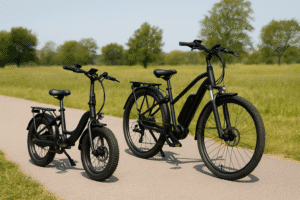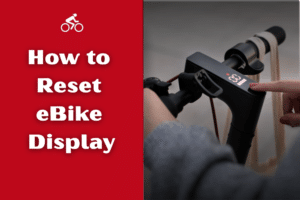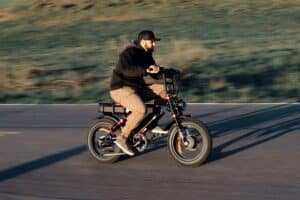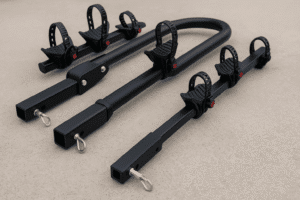If you’re curious about pedal assist e-bikes, you’re not alone.
A pedal assist electric bike uses a motor that only activates when you pedal, making your ride easier without taking away the workout.
It feels natural, helps on hills, and is great for longer rides or daily commutes.
Key Takeaways:
- Pedal assist e-bikes only provide motor support when you pedal, making your ride easier but still active.
- They’re ideal for hills, long distances, and commuting without arriving sweaty.
- The harder you pedal, the more support the motor gives; it feels smooth and natural.
- You can still get a great workout, but with less strain and more control over your effort.
What is a Pedal Assist E-Bike?
A pedal assist e-bike is an electric bicycle with a motor that kicks in only when you pedal. The harder you pedal, the more help you get from the motor. It’s a smooth, natural riding experience that feels just like cycling, just easier.
This type of e-bike blends manual effort with electric power. Unlike throttle e-bikes, you can’t just press a button to go. You have to pedal to get the assist.
This makes it ideal for riders who want support but still want to stay active.
Whether you’re commuting, riding trails, or getting back into shape, pedal assist can make the ride more enjoyable and less tiring.
How Pedal Assist E-Bikes Work
Pedal assist e-bikes work by using sensors to detect when and how hard you’re pedaling. Once you start pedaling, the motor activates and provides power to support your effort. The assist level depends on your input and the settings you choose.
Sensor Types
Pedal assist bikes use two main types of sensors:
- Cadence sensors detect if you’re pedaling. Once you move the pedals, the motor turns on. It doesn’t matter how hard you push; just the fact that you’re pedaling.
- Torque sensors measure how hard you’re pedaling. The motor responds based on the pressure you apply. It gives a more natural and responsive feel, especially useful for hilly or mixed terrain.
Motor and Battery
The motor provides the power, and the battery supplies the energy.
- Motor types: Most pedal assist bikes use either a hub motor (in the wheel) or a mid-drive motor (in the crank). Mid-drive motors tend to feel smoother and climb hills better.
- Battery size: This affects how far you can ride. A typical 36V or 48V battery can give you 20 to 70 miles of range depending on the assist level, terrain, and rider weight.
Together, the motor and battery create a seamless experience, giving you a helpful push when you need it and conserving energy when you don’t.
Pedal Assist vs. Throttle – What’s the Difference?
The key difference is how the motor activates. A pedal assist e-bike requires you to pedal to receive help from the motor. A throttle e-bike lets you ride without pedaling. Just press a button or twist the handle to move.
Here’s a side-by-side look:
| Feature | Pedal Assist | Throttle |
|---|---|---|
| Motor Activation | Only when you pedal | No pedaling required |
| Riding Experience | Feels like traditional biking | More like a scooter or moped |
| Exercise Level | Provides a workout | Minimal or no exercise |
| Legal Classification | Often Class 1 or 3 | Usually Class 2 |
| Battery Usage | More efficient | Drains faster |
Benefits of Pedal Assist E-Bikes
Pedal assist e-bikes make cycling easier, more fun, and more practical for everyday life. Whether you’re commuting or riding for fitness, the benefits are hard to ignore.
- Easier hill climbing: The motor gives you an extra push when going uphill, so you don’t have to strain as much. You can ride farther without burning out your legs.
- Longer rides without fatigue: You still pedal and stay active, but you’re not wiped out after every ride. This makes longer trips or weekend rides more enjoyable.
- Sweat-free commuting: You can arrive at work or a meeting without needing a shower. Pedal assist helps control how much effort you put in, especially in hot weather or hilly cities.
- Adjustable assistance levels: Most e-bikes let you choose from multiple assist settings. You can go full power when tired or use low assist for a more active workout.
- More inclusive riding: Riders of different ages and fitness levels can enjoy biking together. It’s especially helpful for seniors, beginners, or those recovering from injuries.
- Reduced environmental impact: Compared to a car, riding a pedal assist e-bike helps cut emissions. It’s a cleaner, quieter, and more energy-efficient way to travel.
Types of Pedal Assist E-Bikes
There’s no one-size-fits-all when it comes to pedal assist. E-bikes come in different styles to suit different types of riding and terrain.
Commuter E-Bikes
Commuter e-bikes are built for city streets, daily rides, and reliable transport.
They usually have sleek frames, fenders to block water, integrated lights for visibility, and racks for carrying bags or groceries. Most models feature smooth tires for better efficiency on pavement.
Why choose it: Perfect for daily work commutes, quick errands, and urban travel without getting stuck in traffic. You save time and energy while still staying active.
Mountain E-Bikes (eMTB)
eMTBs are made for off-road adventure. They come with suspension forks or full suspension setups, knobby tires, and strong torque from mid-drive motors.
Pedal assist helps you climb steep trails and tackle technical terrain without draining your legs.
Why choose it: If you love trail riding, forest paths, or steep hills, an electric mountain bike gives you power and control where you need it most.
Folding and Compact Models
These are lightweight and easy to store or transport. Folding e-bikes are ideal for people in apartments, those who use public transit, or anyone short on space.
Most models can be folded in under 30 seconds and fit into a car trunk or closet.
Why choose it: Great for commuters who mix riding with trains or buses. Also perfect for travelers, RVers, and anyone who needs a space-saving option.
Fat Tire E-Bikes
Fat tire e-bikes have oversized tires (usually 4 inches or more) that provide better traction and stability on snow, sand, mud, or rough roads.
They’re often paired with powerful motors and high-capacity batteries to handle tough conditions.
Why choose it: Ideal for riders who want to explore off the beaten path or need an all-terrain machine. These bikes feel stable and comfortable, even on bumpy or loose surfaces.
Choosing the Right Pedal Assist E-Bike
The right pedal assist e-bike depends on how and where you plan to ride. Key factors include motor type, battery size, frame style, and your personal comfort needs.
Before you buy, consider what matters most: range, terrain, storage space, or ride feel.
Here’s what to look at:
- Battery capacity: Larger batteries (measured in watt-hours or amp-hours) offer longer range. A 500Wh battery might give you 40 to 70 miles per charge, depending on the assist level and terrain.
- Motor type: Mid-drive motors are better for hills and off-road power, while hub motors are simpler and often cheaper. Choose based on your terrain and riding style.
- Assist levels and controls: Look for bikes with multiple assist settings and an easy-to-read display. Being able to switch modes on the go makes a big difference.
- Frame fit and comfort: Make sure the frame suits your height and body type. Step-thru frames are easier to mount. Suspension helps if you ride on bumpy roads.
- Tires and brakes: Wider tires give more grip and comfort. Hydraulic disc brakes offer better stopping power, especially in wet or steep conditions.
- Accessories and features: Built-in lights, racks, fenders, and smartphone mounts can turn a good e-bike into your everyday ride.
Caring for Your Pedal Assist Bike
A little regular care goes a long way. Keeping your e-bike clean and tuned helps it last longer and perform better.
- Charge smart: Use the recommended charger and unplug once full. Avoid draining the battery completely to extend its lifespan.
- Keep it clean: Wipe down your frame, motor area, and sensors regularly. Use mild soap and water, never a pressure washer.
- Check tire pressure: Under-inflated tires make you work harder and reduce battery range. Top them off as needed.
- Inspect the chain and brakes: Keep the chain lubricated and check your brake pads. Electric bikes are heavier and wear these parts faster.
- Update software (if available): Some e-bikes come with apps or firmware updates. Check for updates to get better battery performance or motor tuning.
- Store It properly: Keep your e-bike in a dry, shaded place. Avoid extreme cold or heat, especially for battery health.
Is a Pedal Assist E-Bike Right for You?
Pedal assist e-bikes are a great choice if you want a balance of physical activity and electric support. You still get the feel and health perks of cycling, but with far less strain.
This type of e-bike is designed for people who want help when they need it, but don’t want to give up the act of pedaling.
You should consider a pedal assist e-bike if you:
- Ride in hilly or windy areas
- Want to commute without arriving sweaty
- Are returning to cycling after injury or age-related challenges
- Like to stay active but appreciate extra help
- Plan to ride longer distances with less fatigue
- Want a fun, flexible way to get around town
Final Words
Pedal assist e-bikes make biking more accessible, more fun, and a lot less exhausting.
You still pedal, but the motor gives you a boost exactly when you need it, on hills, in traffic, or during long rides.
Whether you’re commuting, exploring trails, or just looking for an easier way to stay active, pedal assist is a smart and practical way to ride.
With the right setup and a little care, your e-bike can be a reliable partner for years to come.
FAQs
Can you still get exercise with pedal assist?
Yes, you still get exercise because you have to pedal for the motor to work. You can choose lower assist levels if you want more of a workout or increase support when you need a break.
How fast can a pedal assist e-bike go?
Most pedal assist e-bikes in the U.S. are limited to 20 mph (Class 1 and 2) or 28 mph (Class 3). Once you reach that speed, the motor stops helping, but you can go faster on your own.
Do I need a license or insurance?
In most states, you don’t need a license or insurance to ride a Class 1 or 2 pedal assist e-bike. However, local laws vary, so it’s a good idea to check your state or city regulations.
How long does the battery last?
A typical e-bike battery lasts between 20 to 70 miles per charge depending on assist level, terrain, and rider weight. With proper care, most batteries will last 2 to 5 years before needing replacement.
Can I ride it without using the motor?
Yes, you can pedal a pedal assist e-bike without the motor. It works like a regular bicycle, though it may feel heavier due to the motor and battery.
Al Amin Morshed is the founder of BoltBikers and a seasoned e-bike reviewer with years of hands-on experience testing electric bikes. As a long-time e-bike enthusiast, he combines real-world riding insights with in-depth research to create honest, helpful content for riders of all levels. Through BoltBikers, Morshed aims to make e-biking more accessible, practical, and enjoyable – whether you’re a new rider or a daily commuter looking for the best gear.








